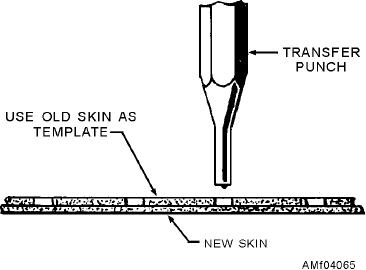
you place the new sheet on the framework to drill the
The rivet holes in stringers, longerons, bulkheads,
holes, make certain that the reinforcing members are
formers, frames, rings, and other internal members
aligned and flush at the points at which they intersect;
must be kept in the best condition possible. If any of
otherwise, the holes in the new sheets will not be
these members are loosened by the removal of rivets,
accurately aligned. For the same reason, the new sheet
their location should be marked so they can be returned
should have the same contour as the old before drilling
to their original position.
the rivet holes.
You should refer to the applicable repair material
To duplicate holes from reinforcing members to the
chart in the aircraft structural repair manual for the
skin, you must exercise extreme care or both frame and
gauge and alloy of material to be used for the
skin will be ruined. Since most bulkheads, ribs, and
replacement panel. The size and shape of the panel may
stringers depend on the skin for some of their rigidity,
be determined in either of two ways. The dimensions
they can easily be forced out of alignment in the drilling
can be measured during the inspection, or the old skin
process. The skin must be held firmly against the
can be used as a template for the layout of the sheet and
framework, or the pressure from the drilling will force
the location of the holes. The second method is
it away from the frame and cause the holes to be out of
preferable and more accurate. Regardless of the method
alignment. This may be overcome by placing a block of
used, the new sheet must be large enough to replace the
wood against the skin and holding it firmly while the
damaged area, and it may be cut with an allowance of 1
drilling progresses. Also, make sure that the drill is held
to 2 inches of material outside the rivet holes.
at a 90-degree angle to the skin at all times, or the holes
If the old sheet is not too badly damaged, it should
will be elongated and out of alignment. When you drill
be flattened and used as a template. The new sheet,
through anchor nuts, a smaller pilot drill should be used
having been cut approximately 1 inch larger than the
first. You must use care so as not to damage the anchor
old, should then be drilled near the center of the sheet
nut threads. The pilot holes are then enlarged to the
by using the holes in the old sheet as a guide. The two
proper size.
sheets are then fastened together with sheet metal
It may be necessary to use an angle attachment or
fasteners. The use of sheet metal screws is not
flexible shaft drill in places where it is impossible to
recommended since they injure the edge of the rivet
insert a straight drill. In case neither type can be
holes. The drilling should proceed from the center to
inserted, the new section should be marked carefully
the outside of the sheet. You should insert sheet metal
with a soft pencil through the holes in the old section.
fasteners at frequent intervals.
Another method of marking the location of the new
If it is impossible to use the old sheet as a template,
holes is to use a transfer or prick punch, as shown in
the holes in the new sheet should be drilled from the
figure 4-65. Center the punch in the old hole, and then
inside of the structure. Use the holes in the reinforcing
tap the punch lightly with a hammer. The result should
members as guides, and insert fasteners at frequent
be a mark that will serve to locate the hole in the new
intervals. This process is called backdrilling. Before
sheet.
Figure 4-65.--Transferring rivet holes.
4-41

